

How Much Does Education Improve Intelligence? A Meta-Analysis - Stuart J. Ritchie, Elliot M. Tucker-Drob, 2018. Scientists Transferred Memories From One Snail to Another. Someday, Humans Could, Too. Prosthetic Memory System Successful in Humans - Neuroscience News. Summary: There is new hope for people suffering from memory related problems.
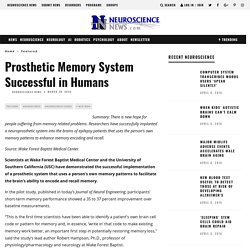
Researchers have successfully implanted a neuroprosthetic system into the brains of epilepsy patients that uses the person’s own memory patterns to enhance memory encoding and recall. Source: Wake Forest Baptist Medical Center. The Human Brain vs. Artificial Intelligence. While artificial intelligence is currently the hot topic in the field of neuroscience, AI technology is very different from the human brain.
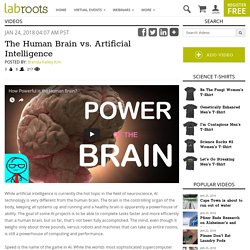
The brain is the controlling organ of the body, keeping all systems up and running and a healthy brain is apparently a powerhouse of ability. The goal of some AI projects is to be able to complete tasks faster and more efficiently than a human brain, but so far, that's not been fully accomplished. The mind, even though it weighs only about three pounds, versus robots and machines that can take up entire rooms, is still a powerhouse of computing and performance.
Speed is the name of the game in AI. How to Build a Mind? This Theory May Guide Us Toward an Answer. Brain device boosts learning in monkeys by 40% 7th November 2017 Brain device boosts learning in monkeys by 40% Scientists funded by DARPA have developed a non-invasive cap that stimulates parts of the brain via electrical currents and is shown to improve the learning abilities of macaques.

In the not-too-distant future, this technology could be used by humans. Researchers from HRL Laboratories (California), McGill University (Montreal, Canada), and Soterix Medical (New York) have collaborated on a study of transcranial direct current stimulation (tDCS) in monkeys. Funded by the Defense Advanced Research Projects Agency (DARPA), their work is published in the peer-reviewed journal Cell. Mobilité des récepteurs synaptiques : découverte d'un nouveau mécanisme du contrôle de la mémoire.
Les neurones communiquent entre eux par l'intermédiaire de plus d'un million de milliards de synapses, de toutes petites structures de la taille d'un dixième de cheveu, au fonctionnement extrêmement complexe.

A Math Model Shows How Neurons Fire in the Brain. Neuroscientists are not the only ones who have wished that there was a way to see how the brain processes information and stimuli.
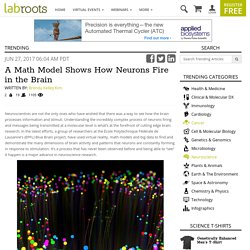
Understanding the incredibly complex process of neurons firing and messages being transmitted at a molecular level is what’s at the forefront of cutting edge brain research. In the latest efforts, a group of researchers at the École Polytechnique Fédérale de Lausanne’s (EPFL) Blue Brain project, have used virtual reality, math models and big data to find and demonstrate the many dimensions of brain activity and patterns that neurons are constantly forming in response to stimulation. Le cerveau hiérarchise les mots. Une étude menée par des chercheurs du CEA a montré que le cerveau structure les phrases qui lui parviennent en ensemble de mots formant une syntaxe complète, ce qui appuie une théorie bien connue des linguistes, la théorie des arbres syntaxiques.
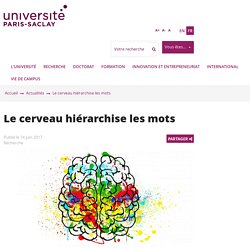
Vous êtes en train de comprendre cette phrase que vous lisez. Mais savez-vous pourquoi ? Des chercheurs du CEA et de l’INSERM ont publié en avril dans Proceedings of the national academy of Science (PNAS) un article révélant de grandes avancées dans la recherche du mécanisme de compréhension des éléments de langage par notre cerveau. Le cerveau analyse les phrases qui lui parviennent. Leur cohérence est le résultat d’une décortication méticuleuse de leur structure et de leur sens. Une étude qui plonge dans votre tête. This One Equation May Be the Root of Intelligence. How does intelligence work?
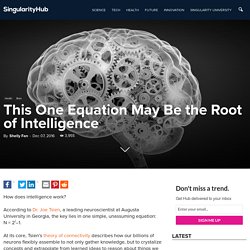
According to Dr. Joe Tsien, a leading neuroscientist at Augusta University in Georgia, the key lies in one simple, unassuming equation: N = 2i–1. How to Build a Mind? This Learning Theory May Hold the Answer. How do intelligent minds learn?

Consider a toddler navigating her day, bombarded by a kaleidoscope of experiences. How does her mind discover what’s normal happenstance and begin building a model of the world? Coup de tonnerre dans le domaine des neurosciences : le cerveau humain a une capacité de stockage 10 fois plus importante que ce que l'on pensait auparavant. Actualités > À Chaud > Coup de tonnerre dans le domaine des neurosciences...

Learning To Learn Faster: The One Superpower Everyone Needs. I have a new book coming out early next year, The Rise of Superman: Decoding the Science of Ultimate Human Performance.
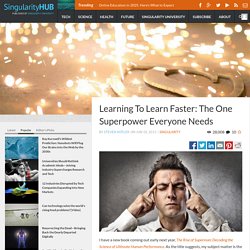
As the title suggests, my subject matter is the outer limits of human potential and the question of what might actually be possible for our species. During the course of writing this book, I’ve been lucky enough to meet a lot of amazing people interested in this very same question. This is a story about one of them, a really nice guy named Jim Kwik. It’s also a story about learning and education, innovation and entrepreneurship, and, well, superheroes. Actually, mostly, it’s a story about superheroes. Watch: What Is Consciousness? We Now Have the Tools to Find Out. The question of consciousness is as old as philosophy. And while the exact nature of human consciousness is exceedingly difficult to pin down—that doesn’t stop us from trying. It's a puzzle that's preoccupied the world’s greatest philosophers for millennia and, in recent centuries, scientists too.
In the information age, we've begun to wonder if consciousness is a uniquely biological phenomenon or if it might arise elsewhere. Is the brain just a mushy computer running wetware—something we can replicate in hardware and software? Or is comparing the brain to a computer a misleading analogy and a vast oversimplification? A fascinating new video from the Economist, featuring some of the brightest minds working the problem, brings us up to date on the debate and the latest thinking. How the Brain Makes Memories: Scientists Tap Memory’s Neural Code - Singularity HUB. Some of our most treasured memories begin with a simple association: the smiling face of that special someone, tied forever to the place where you first met.
Sadly, these episodic memories — memories that encode life events — are often eroded in neurological disorders such as Alzheimer’s disease or traumatic brain injury. Without tapping into the basic neural code that underlies these associations, scientists are limited in how they can help people suffering from memory loss. However, thanks to a new study published in the July issue of Neuron, we are a step closer to understanding how our brains place people into context. The answer lies in a handful of single neurons in the medial temporal lobe (MTL), which rapidly change their firing patterns at the exact moment someone learns a new association between person and place. The story begins more than a decade ago, when the study’s senior author, Dr. Brain Synapses Last as Long as Memories do. Our memories are stored in brain connections called synapses. And according to a new Nature study, synapses aren’t permanent structures: They only last as long as the memories they store.
Brain Cells Break Their Own DNA to Allow Memories to Form. While that may sound counterintuitive, it turns out that the damage is necessary to allow the expression of a set of genes, called early-response genes, which regulate various processes that are critical in the creation of long-lasting memories. These lesions are rectified pronto by repair systems, but interestingly, it seems that this ability deteriorates during aging, leading to a buildup of damage that could ultimately result in the degeneration of our brain cells. This idea is supported by earlier work conducted by the same group, headed by Li-Huei Tsai, at the Massachusetts Institute of Technology (MIT) that discovered that the brains of mice engineered to develop a model of Alzheimer’s disease possessed a significant amount of DNA breaks, even before symptoms appeared. These lesions, which affected both strands of DNA, were observed in a region critical to learning and memory: the hippocampus.
New Math Model Shows How Neural Networks Create Memories. Scientists at EPFL have uncovered mathematical equations behind the way the brain forms – and even loses – memories. Memory is one of the most crucial elements of life. Without memory, there is no learning; without learning there is no invention, progress, or civilization. On the flipside, forgetting some experiences, especially traumatic ones, can help regain mental health and function. The key to all this is to understand how the brain forms memories in the first place, and then how it retains and recalls them. Scientists at EPFL have developed a mathematical model to describe how networks of neurons create memories. Closer to AI: Electronic Long-Term Memory Cells Mirror Human BrainTrending. Memory is one of the more complex functions of the human brain.
The best brain supplement to delay memory and thinking decline: A mentally stimulating job. By: SharpBrains Challenging Work Tasks May Have an Upside for the Brain (new study): “Professionals whose jobs require more speaking, developing strategies, conflict resolution and managerial tasks may experience better protection against memory and thinking decline in old age than their co-workers, according to a new study published in the April 29, 2015, online issue of Neurology, the medical journal of the American Academy of Neurology.
Neurons Busily Rewrite Their DNA NonstopTrending. Scientists from Johns Hopkins have found that neurons are not risk-averse, if fact, they use minor "DNA surgeries" to toggle their activity levels 24/7. Since these activity levels are important in learning, memory, and brain disorders, the researchers believe their finding will shed light on several key questions. These are images of mouse neurons from the hippocampal region of the brain. How brain waves guide memory formation. How "SuperAger" Brains Are Different Than Everyone Else's. Researchers working with SuperAgers—people aged 80 and up with impeccable memory—reveal how their brains look decades younger. And compared to others their age, SuperAgers have nearly 90 percent fewer brain “tangles” linked to Alzheimer’s disease. The findings were published in the Journal of Neuroscience last week.
Long Term Memories May Not Be Stored In Synapses Afterall. It has long been believed that memories were stored in the synapses of neurons. So, when those synapses were destroyed, the memories they held must be lost as well. However, a new study involving marine snails known as Aplysia has found that this might not be the case. If true, this could lead to memory restoration for patients with early onset Alzheimer's. Steve Ramirez and Xu Liu: A mouse. A laser beam. A manipulated memory. Close Help with subtitles Desktop / laptop users: please make sure you have the most updated versions of your browser and Flash player, and that Flash is enabled when you visit TED.com. Scientists Discover A Process That Regulates Forgetting. Where did I park the car? La tête d’un ver décapité repousse… avec sa mémoire.
Visant à fabriquer de nouveaux organes pour remplacer ceux qui se révèlent défectueux, la médecine régénératrice est un domaine en pleine expansion. Un domaine qui pose aussi des questions inattendues lorsqu’il touche au cerveau : pour les personnes souffrant d’une maladie neurodégénérative comme la maladie d’Alzheimer, qu’arrivera-t-il aux souvenirs stockés depuis l’enfance lorsqu’on repeuplera le cerveau avec des neurones tout neufs issus de cellules souches ? New Neurons Erase Old Memories In Mice. Scientists Selectively Erase And Restore Memories.